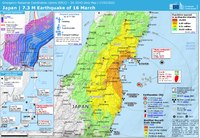
Photo from wikipedia
Postseismic deformation following the 2011 Tohoku-Oki earthquake has been observed by the Global Navigation Satellite System (GNSS) Earth Observation Network System (GEONET) and the Seafloor Geodetic Observation (SGO) over the… Click to show full abstract
Postseismic deformation following the 2011 Tohoku-Oki earthquake has been observed by the Global Navigation Satellite System (GNSS) Earth Observation Network System (GEONET) and the Seafloor Geodetic Observation (SGO) over the past six and half years. Observed deformation at onshore sites exceeds 140 cm horizontally, there is uplift of 50 cm, and deformation tends eastward. However, offshore sites reveal complex patterns ranging from near-zero deformation in the northern part of Iwate-Oki, to westward in the southern part of Iwate-Oki, Miyagi-Oki, and the northern part of Fukushima-Oki regions, and eastward in the southern part of Fukushima-Oki and Ibaraki-Oki regions, respectively. The vertical deformation pattern is more complex than the horizontal. Offshore sites demonstrate subsidence but a large uplift is observed onshore along the Pacific coast. Subsidence is only observed along the Pacific coast in the northern part of Iwate, where there are variations in uplift or subsidence patterns. Many previous 2011 Tohoku-Oki event studies have used a primary model that considers only the afterslip effect. However, westward displacements observed by the SGO highlight the importance of viscoelastic relaxation, even during short-term deformation. It is thus considered that studies on postseismic deformation following the 2011 Tohoku-Oki earthquake should adopt a combined afterslip and viscoelastic model. Postseismic deformation following this event is estimated to continue for more than a few decades; therefore, assessing this effect is crucial for interpreting crustal deformation in Japan. Information on the status of interplate coupling or slip is also vital when assessing earthquake occurrence probability. The continued observation of postseismic deformation and careful monitoring of temporal and spatial changes in interplate coupling or slip will mitigate hazards from successive large megathrust earthquakes and improve understanding of crustal activity in Japan.
Journal Title: Journal of Disaster Research
Year Published: 2018
Link to full text (if available)
Share on Social Media: Sign Up to like & get
recommendations!